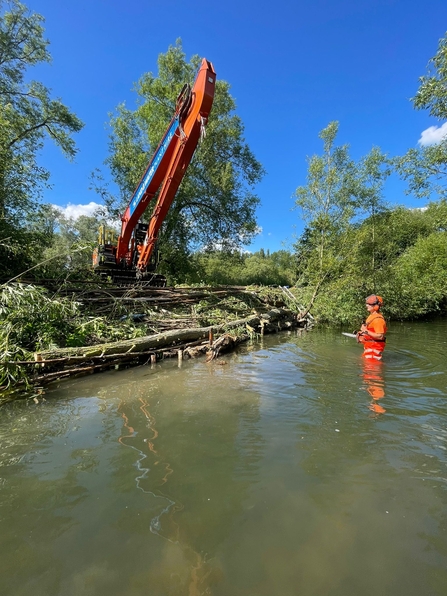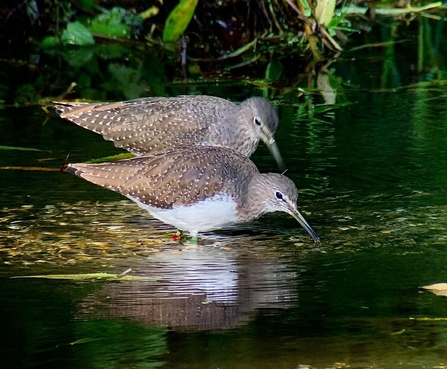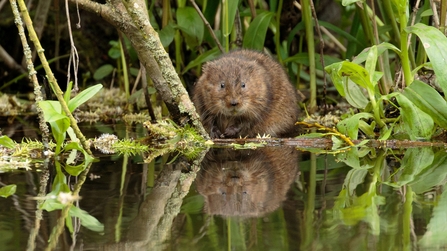Over the last six years, the Trust has sought to increase practical restoration of degraded stretches of chalk rivers, led by Sarah Perry, our River Catchment Coordinator. Sarah works with a diverse range of collaborators including private landholders, local authorities, local community groups and angling clubs. Through this over 18 hectares of river valley have been restored – increasing resilience to flooding and climate change, improving backwater connections, creating more connection to flood plains, putting the wiggles back in - all of which contributes to nature’s recovery.
Making Progress on our Chalk Rivers
Restoration works on the River Ash - August 2024

Sarah Perry, River Catchment Coordinator overlooking the River Lea
Earlier this year, a welcome next chapter came in the form of an announcement that the Trust would benefit from a £1.7 million funding award from the Species Survival Fund, which is being delivered by The National Heritage Lottery Fund on behalf of Defra. The funding will enable further restoration of 11km of our chalk rivers, reconnect up to 49 hectares of floodplain and improve four hectares of wetland habitats across Hertfordshire. Protecting these key habitats will not only help to mitigate the impacts of climate change by providing natural flood management but will also help halt the decline of over 109 different species including Water Voles, the UK’s fastest declining mammal.
This funding will also enable long term baseline monitoring to take place and create a greater understanding of the species recorded on our chalk rivers so that we can improve their prospects for future survival.
Here, Sarah talks about two ongoing projects, which will benefit from the funding.

Restoration on works on the River Ash - August 2024
The River Ash
In August 2022, work started on the River Ash, tackling the first kilometre out of seven planned for restoration, as a partnership effort between the Trust, the Easneye Estate and Environment Agency, thanks to funding from the Green Recovery Challenge Fund.
Over 600m of river bank was lowered and 500 tonnes of gravel put back into the river bed to address the historic impacts that dredging has had on the river. Reconnected meanders and restored ditches created over 150m of new low flow refuge areas and woody habitat provides cover around the edges of the river. The work which took place over three weeks, using contractors, RJ Bull, has improved the prospects for a range of wildlife that the river supports, including native wild Brown Trout, Kingfisher and critically endangered Water Vole.
DEFRA’s Species Survival Funding and Environment Agency support has enabled our partnership work with the Easneye Estate to continue in summer 2024, restoring another 3km of the River Ash for endangered wildlife.
Key natural processes and features “lost” from the river through centuries of dredging, straightening and re-aligning have been reinstated – creating the foundations for a healthy river corridor that is well connected to a variety of wetland habitats, helping to aid nature’s recovery into the future.
Over 1km of banks have been lowered and sculpted, restoring an “ecotone” connection between dry land and open water, reinstating much needed margins for Water Vole to forage lush vegetation and the ability for high flows to be accommodated within inset floodplain to help future proof against climate change.
Over 5,000 tonnes of natural gravel have been returned to the river bed, creating over 50 new spawning areas for wild Brown Trout, Grayling and other fish. These have been established with native Water-crowfoot, a typical chalk stream plant that oxygenates the river, amongst other marginal plants being established along the river edges.
300m of spring-fed ditches have been restored and reconnected to the river and 100m of backwater habitat (important slow flow channels that support juvenile fish) has been created, as well as creation of two new ponds and several hibernacula, providing different wetland niches for freshwater wildlife.
With thanks to the Easneye Estate for their unwavering support to protect the river’s wildlife and delivery partners RJ Bull who have been instrumental in bringing the restoration to life through its construction.

River Lea at Lemsford Springs Nature Reserve
The River Lea
Connectivity is key to nature’s recovery and through an ambitious long-term project, we are working towards joining-up two of our nature reserves – Lemsford Springs and Stanborough Reedmarsh near Welwyn Garden City - by enhancing 2km of the River Lea.
As wetland sites crucial to nature in mid-Herts, Lemsford Springs and Stanborough Reedmarsh received funding for restoration from Highways England in 2021. Separated by the A1M in an urban part of Welwyn Garden City, these two reserves are home to unique wildlife including Green Sandpiper, Grasshopper Warbler and Barbel – a fish once widespread along the River Lea but now only found in good numbers in a few places. Sadly, as a result of climate change and human pressure on the water cycle, both reserves are impacted by drought and flooding on a regular basis, making their wetland habitats vulnerable to degradation.

Green Sandpipers at Lemsford Springs © Barry Trevis
After many years of planning, restoration work is currently taking place at the reserves (September and October 2024) to reinstate their key wetland habitats and enhance 500m of the River Lea at Lemsford, helping it to buffer the impacts of drought and flood more resiliently and reduce impacts to the sensitive chalk stream lagoons nearby.
Two ponds are being enlarged, one new pond is being created and a new backwater off the river has been scraped out to protect juvenile fish and support a range of dragonflies using the sites.
Two hectares of priority reedbed habitat is being reinstated at Stanborough by removing half a metre of thatch that had built up over many years. The springs are being future-proofed by bunding, allowing more mineral-rich water to be retained on site to supply the reedbed for longer into the summer.
Over 600m of ditch network is also being opened up, creating much needed open water habitat within the reedbed. This will support a variety of insect life and, in turn, birds such as Reed Bunting and Grasshopper Warbler recorded at the site.
This first stage of our project will be completed in October 2024, with funding from National Highways. We will be restoring the rest of the River Lea through Stanborough Park in 2025 with funding from DEFRA’s Species Survival Fund, in partnership with Welwyn Hatfield Borough Council, Better Leisure and Stanborough Angling Club.
Through this, 1.5km of river will be improved through introduction of large woody habitat features, bank regrading, creation of wetland features next to the river and bankside tree management, to ensure a more vibrant chalk stream that better supports a range of native fish, mammals and birds.

Water Vole (c) Michael Talbot
Next steps
To find out more about our work on local chalk rivers, and how you can play your part in their recovery and restoration, click here.
It is vital that we continue to drive nature’s recovery forward – as this blog demonstrates, we know what we must do and have the expert skills required however, rising costs leave us in a frustrating situation where we simply do not have the resources to do all that we can. If you can help by donating to our Wildlife in Crisis Appeal, your donation will go to the heart of our conservation work, allowing us to continue restoring vital ecosystems and supporting our most vulnerable wildlife. Thank you.

